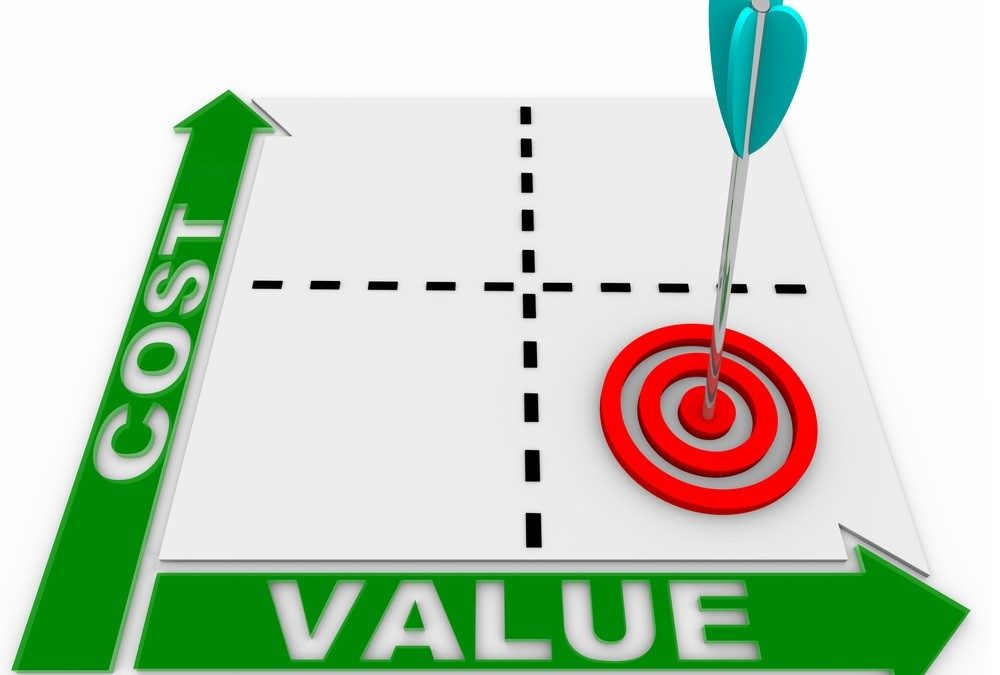
by Art Waskey | Sep 26, 2022 | Art of Sales Weekly, Featured
How to Measure Success
While VP of Sales, I oversaw a hospital account that was among our leading 10 customers. Their purchases topped the charts. Yet our CFO questioned the account’s profitability when their contract came up every 5 years. Due to the competitive pressures in healthcare, the pricing of the products was not increasing from contract to contract. The volume was tremendous and the product mix carried some of the best gross margins. The question kept coming up about the account’s net profit. How do you measure your high-value customers in today’s diverse marketplace?
Determining Profitability
In the seminal book, “Choose Your Customer”, Jonathan Byrnes and John Wass state: “determining the true profitability of our customers is one of the biggest problems for companies today.” They described the shift from the Age of Mass Markets, where managers had a clear responsibility to look after their unique department, to the Age of Diverse Markets in which managers are responsible for net profit contribution. With today’s robust digital ERP capabilities a company can perform transaction-based profit metrics and analytics across multiple fields.
Byrnes and Wass explain, “Instead of assuming that revenue maximization is the objective of the account management process, leading managers now understand that directly maximizing all-in customer net profitability is the right objective.”
The Net Profit Viewpoint
Additionally, In the Age of Diverse Markets, it is feasible to look at each transaction from a net profit viewpoint. This is accomplished by digitally collecting all cost aspects of each transaction. In the opening hospital illustration, there were exorbitant distribution costs involved in making deliveries to multiple locations. Furthermore, deliveries consumed a driver’s full day on multiple days each week. Additional costs accrued by having to correct persistent administrative and billing issues unique to the account. All costs considered, the hospital account produced negative net profits. It was not a high-value account and was reclassified as a profit drain.
Sales Effectiveness
Lastly, with digitally evaluated transaction-based profit metrics and analytics, companies can move to the ultimate level of sales effectiveness. High-value customers should no longer be appraised on revenues, or gross margins, but on their net profit contribution.
Get more tips and tricks by purchasing The Art of Sales books. Or subscribe to the FREE monthly articles here.

by Art Waskey | Sep 19, 2022 | Art of Sales Weekly, Featured
Get Organized
Twenty years ago, as the VP of Sales for industrial gas and welding supply company, I started writing a monthly column, “The Art of Sales,” for CryoGas International (now Gasworld). The magazine focused on the industrial gas distribution business. My articles were directed at that audience and contained sales tips and stories. Today I am a consultant to that sector, have my own blog and continue to contribute to industry publications. While I still write on sales skills, I have noted that the rapid and critical change in commerce has prompted the need to concentrate more on digital and organizational practices. Many clients are asking, “What should I do with my business now?”
The Digital Transformation
Furthermore, much of my writing relates to how to deal with the marketplace disruption caused by the pandemic. For example, consultants no longer spend their time on planes in order to make face-to-face meetings. Appointments are now virtual. Also, COVID accelerated the digital transformation, and the distribution business, like all others, is feeling the shift.
Advanced ERPs, eCommerce, and virtual product content have radically changed sales responsibilities. Furthermore, Reps have moved from product presentations, quoting, checking inventory, and tracking orders, to added-value consulting and answering questions about products the customer procurement team has already researched online. Also, the distributor faces the added challenge of competing with manufacturers that can sell directly to customers, or through marketplace alternatives.
Business Choices
These facts beg the question – what do I do with my independent distributorship now? I have observed three typical responses:
- Sell out to a conglomerate
- Transfer the business to your employees through stock ownership programs, such as ESOPs
- Hire a qualified consultant to bring your company up to date
Primary Priorities
Regarding option 3, there are qualified senior executives with years of experience who know how to navigate the distributor’s challenges in the digital marketplace. Thus, The most essential primary priorities are to apply organic/systemic organizational skills nimbly and invest in digital proficiency. The most effective means to accomplish this urgent progression is finding people that understand your business – those who have “walked in your shoes.” Henceforth, talent can be developed internally or externally. You probably already have employees who have unidentified digital skills that could be enhancing your business.
In conclusion, what should you do with your business to compete in today’s marketplace? Develop your organizational skills and digital proficiency … and do it now.
Get tips and tricks like the above in The Art of Sales books. Or subscribe to the FREE monthly articles here.

by Art Waskey | Sep 12, 2022 | Art of Sales Weekly, Featured
A lot to Consider
As an independent regional distributor, you need to take a close look at where to invest your digital dollars. In a recent MDM webcast, Alex Moazed and Nick Johnson talk about distributors entering the digital domain. They discuss the recent proliferation of industrial-specific verticals: Berkshire e-Supply (industrial products), Bluon (HVAC), Parts Town (OEM foodservice equipment), Volition (industrial parts), and ODP Corp.’s Varis platform (office products). Moazed and Johnson emphasize that digital B2B marketplaces aren’t for everyone. Before getting involved, consider your distributor differentiation.
A Small Slice of the Pie
Moazed and Johnson point out, that while the level of investment in digital marketplaces from distributors is undoubtedly accelerated in recent years, it’s still coming from just a very small slice of the pie. In the atmospheric gases industry, a few forward-thinking companies got into marketplace verticals early. Most have found the margins slim. Furthermore, digital sales appear to be an alternative to buying from the company’s mortar and brick stores and are regional in nature.
Focus on Analytics
The historical strength of the independent distributor is in its local resources and relationship to its customer base. Rather than investing in buying platforms, focus on improving your technical skills, facilities, and personnel. Additionally, the best investment you can make is in digitizing and growing your analytics. As Jonathan Byrnes and John Wass suggest in their book, “Choose Your Customer”, take a close look at your high-profit customers through transaction-based profit metrics. Track their erosion and growth. Byrnes and Wass suggest marking these accounts in the database so that your customer contact people know who they are. Build teams within your organization that focus on your relationship with these customers.
Walk in their Shoes
Lastly, find ways to walk in your high-profit customers’ shoes. Join with select clients to identify and develop new value footprint opportunities, ones that may not be obvious initially. Your high-profit customer relationship is your distributor differentiation.
Get tips and tricks like the above in The Art of Sales books. Or subscribe to the FREE monthly articles here.

by Art Waskey | Aug 29, 2022 | Art of Sales Weekly, Featured
Key Differentiator
Many B2B purchases are made before a consumer even contacts a vendor. According to data from SiriusDecisions, 67% of the purchasing process is completed digitally. In spite of this, one of my first areas of focus as a consultant to small business entrepreneurs is improving their digital platforms. According to a survey conducted by The Brooks Group, “Eighty- seven percent of B2B buyers say they would pay more to a supplier with better digital tools. Furthermore, Enabling digital transformation has become another key differentiator.”
Steps to Digital Integration
How can a growing small business affordably upgrade its digital platform? I suggest considering these steps:
Find the right ERP provider – With the right ERP software, you can collect, store, manage, and interpret data from all your business activities. In many ways, it is similar to the operating system on your computer. Make contact with several ERP providers and get quotes from each. In addition, Look for groups active in your industry. Using the Internet and your network are both good ways to find out about many groups. On the other hand, based on previous experiences, it may be best to offer cost savings. Innovations will reduce costs as technology advances, but competition and product development will increase as well.
Add a B2B eCommerce integrator – A provider can create the software to electronically allow buying and selling of products through online services or over the internet. A B2B integrator provides strategy, software, and solutions to integrate your ERP with that of your customers. The measuring system is the communication piece between the supplier and its customers. It allows you to set up an eCommerce platform for each end-user.
Be Digitally Competent
Finally, your website is only the start of your digital journey. To compete in the challenging world of eCommerce, you must be digitally competent. Your website must be visually appealing as well as digitally established. Consider hiring a developer who can help create a digital foundation for your business and marketing efforts. Lastly, as the number and size of alternative internet providers grow, enabling digital transformation will be a key differentiator to your business’ success.
Get tips and tricks like the above in The Art of Sales books. Or subscribe to the FREE monthly articles here.

by Art Waskey | Aug 22, 2022 | Art of Sales Weekly, Featured
Remind Customers of Your Value
As Benjamin Franklin said, “The bitterness of poor quality remains long after the sweetness of low price is forgotten.” In today’s world of competitive alternative virtual purchasing channels, it’s important to remind your customers that price isn’t everything. Learn to justify your price.
At the beginning of my career, I worked for an international atmospheric gas and welding company as a territory sales engineer. There were eight independent distributors in Texas who were my customers. Floyd was the sales manager for one of those Fort Worth distributors.
He allowed me to listen to a return call to one of his top 10 accounts. The customer was leaving them for lower pricing. Floyd reminded the buyer of the special inventory his company had stocked for them and the added services they provided. Then, he thanked the buyer for their years of business. After the call, Floyd told me the customer would be back within 6 months. He was right. Lastly, Floyd has successfully justified his pricing.
New Pricing Pressures
Today sales calls are a world apart from my experience with Floyd in the 70s. With a multitude of alternative channels available to the buyer, we face very different competitive pricing pressures. Some basic sales principles never change, however. Consider these suggestions when faced with lower pricing pressure.
The fear of the unknown – Remember the last time you bought something online and received a product you didn’t expect? What was it like to return it? It probably was an ordeal you would rather not repeat. As an independent distributor, your customer knows he/she can count on you to resolve issues without a hassle. Remind them of this value that you offer. The fear of the unknown often outweighs the gain of a cheap price.
The total cost of business – In our distributorship, we recorded all customer interactions in call reports. In annual review meetings with our top customers, we would share the list of the added-value services provided and included in the price. Those services included deliveries per month, technical assistance, order fill rate, face-to-face rep calls, vendor joint calls, and eCommerce order rates. By making our customers aware of the cost associated with delivering added values, they perceived our price as justifiable.
Understanding True Value
As Steven Tyler once said, “You’d be surprised how expensive it is to look this cheap.” Justify your price. Make the case that price isn’t everything by letting your customers know the true value of your business relationship.
Get tips and tricks like the above in The Art of Sales books. Or subscribe to the FREE monthly articles here.

by Art Waskey | Aug 16, 2022 | Art of Sales Weekly, Featured
Technical Abilities
A young woman came into a distributor’s store to buy a robot to automate her company’s business. The counterperson referred her to their trained technical sales rep. She made him aware of the options she needed on the robot and seemed to know more about the product than he did.
She quizzed the rep on his technical capabilities and asked if their company could train and service the robot. This scenario should not be a surprise to anyone who follows purchasing trends.
The Procurement Department as a Client
While salespeople once worked with purchasing agents, in today’s digital world, they will more likely be answering the needs of procurement departments.
In her article, “Making Procurement Part of the B2B Sales Process,” Michelle Richardson states, “77 percent of B2B buyers don’t talk to sales reps until the buyer has done their research, and 99 percent are comfortable spending $50,000 or more using a self-service web portal.
In addition, “The procurement department is responsible for identifying needs, sourcing suppliers, negotiating and managing contracts and costs, including ways to save money.”
The shift in Sales Attention
As in the example above, the purchasing process now includes assessing the seller’s added-value capabilities on complex products and services. B2B selling is a collaborative effort and is about personal relationships.
Furthermore, Suppliers must create new partnering principles to enable data sharing and transparency while protecting proprietary interests. It is important to determine the needs of all decision-makers and determine who controls the purchase.
Lastly, The shift of sales attention from purchasing departments to procurement groups is part of the new digital sales cycle. Be sure you understand your customer’s organizational dynamics and use Enterprise Selling techniques to remain competitive.
Get tips and tricks like the above in The Art of Sales books. Or subscribe to the FREE monthly articles here.






